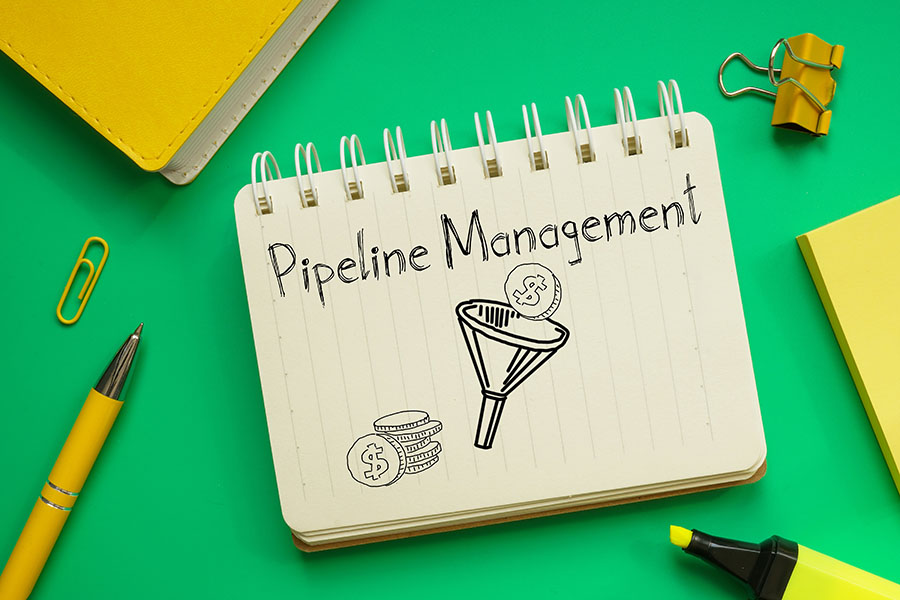A sales pipeline is an illustration of the sales process that outlines the current number of deals worked on by the sales team, along with the stage of each deal and the time required to close them.
It is an indispensable aspect of the sales process. Without a pipeline, you lack information on where deals are, how sales reps should proceed, and how effective your sales process is.
Proficient management of the sales pipeline can help businesses attain their sales targets and increase conversion rates, leading to growth. This article delves into the advantages of implementing a sales pipeline and the various stages that are involved.

The importance of a sales pipeline
Any sales plan must include a sales pipeline since it allows sales teams to keep track of the status of active deals and their various stages. Sales managers can then identify any areas for improvement, mentor and support their staff, and tweak the sales procedure to increase conversion rates.
A sales pipeline also makes it easier to expect sales, determine how long it takes to close deals, and give marketing teams useful feedback on how to produce leads that fit the pipeline’s various stages.
Better Sales Forecasting
A sales pipeline gives a comprehensive insight of active deals and the stage of the sales. To accurately predict future sales, sales leaders need an active sales pipeline. Sales executives can expect the prospective revenue for a period by examining the data in the sales pipeline and changing their strategy accordingly.
Improved Collaboration
The sales team, marketing teams, and other departments involved in the sales process can collaborate more effectively when there is a sales pipeline in place. Team members can better collaborate and be more productive by exchanging information about the pipeline stage and offering each other insightful advice and support.
Efficient Resource Allocation
Companies can distribute resources wisely when they have a strong sales funnel.
Often, sales managers ensure teams have the tools they need to drive prospects along the sales funnel by monitoring the pipeline stage. This aids in streamlining the sales procedure, speeding up the closing of deals, and raising the sales team’s general effectiveness.
Improved Customer Experience
Businesses may improve the customer experience by maintaining a properly managed sales pipeline.
Sales teams may offer specialized solutions and ease customer pain points by keeping track of the pipeline stage and comprehending the needs of the customer. This creates long-lasting relationships with customers by helping them when they need a solution.
Identify Weaknesses
The sales pipeline provides valuable insights into the sales process, enabling sales leaders to identify areas of weakness.
By analyzing pipeline data, sales leaders can determine where most prospects drop out, adjust their sales strategies, and provide the support to team members.

The Stages of a Sales Pipeline
A sales pipeline has several stages that reflect the customer’s journey starting from lead generation until closing the deal.
The stages of the pipeline may differ depending on the product or service being offered. But the important steps are identifying potential customers, qualifying leads, presenting offers, and finally closing deals.
The sales team must focus on moving prospects through each stage of the pipeline to maximize the chances of closing the deal.
Lead Generation
The first stage of a sales pipeline is lead generation. This includes identifying potential customers who are interested in the offered product or service.
You can achieve lead generation through various methods, like advertising, content marketing, email marketing, and social media marketing.
Qualifying Leads
After generating leads, the next step is to qualify them to determine if they are a good fit for the product or service being offered.
This involves gathering more information about the prospect, such as their needs, budget, timeline, and decision-making process.
Qualifying leads help to focus on the most promising opportunities, reducing the time and resources spent on prospects that are unlikely to convert.
Presenting Offers
Your sales staff can give prospects offers after they have been qualified. This might entail a demonstration or sample of the product, responding to inquiries, or addressing worries.
The aim is to persuade the potential customer to buy.
Closing Deals
A sales pipeline ends with this phase. This stage involves the prospect making a choice to buy and completing the deal.
Deal closure causes resolving any issues the prospect may have.
Follow-up and After-Sales Service
After closing a sale, the sales team must provide excellent follow-up and after-sales service to maintain customer satisfaction and loyalty.
This may include providing onboarding, training, and ongoing support to ensure that the customer is getting the most out of the product or service.

Sales Pipeline Management
Monitoring progress at each pipeline stage and ensuring that team members have adequate resources are both essential components of effective sales pipeline management.
Sales leaders can find areas for improvement and learn how long it takes to move prospects from one stage to the next by conducting regular pipeline evaluations.
The sales team must cooperate in order to support one another and make sure that they efficiently control the pipeline at each step.
Clear Sales Pipeline Stages
Effective sales pipeline management requires clear and well-defined stages of the pipeline.
This helps sales teams to understand the progression of deals and enables sales leaders to analyze the pipeline and forecast future sales.
Regular Pipeline Reviews
For effective sales pipeline management, regular pipeline reviews are essential. This entails evaluating the progress of agreements that are in the pipeline, spotting any bottlenecks or weak spots, and making any necessary corrections.
Regular pipeline reviews should be carried out, perhaps once a week or once a month.
Data-Driven Insights
To make wise decisions, sales pipeline management needs data-driven insights. Sales managers should evaluate the pipeline and pinpoint opportunities for improvement using data like conversion rates, lead velocity, and deal size.
CRM Software
A CRM (Customer Relationship Management) program is an effective tool for managing the sales pipeline. Sales teams may track prospects, manage contacts, and analyze sales data with the aid of CRM software.
This makes it possible for sales managers to allocate resources more wisely and manage the pipeline more successfully.
Sales Team Training
Sales team members must be knowledgeable about the sales process and capable of managing their deals in order to efficiently manage the sales pipeline.
To guarantee that team members have the abilities to manage the pipeline efficiently, sales executives should train and support them.
Sales Pipeline Automation
Automation of the sales funnel can speed up the selling process and provide sales teams more time. This entails automating processes like appointment scheduling, follow-up emails, and lead creation.
Automation of the sales pipeline can increase productivity, decrease errors, and give sales team members more time to concentrate on closing deals.

Benefits of a Sales Pipeline
Employing a sales pipeline can aid businesses in elevating their conversion rates, attaining sales targets, and augmenting their revenue.
By pinpointing the stage in the pipeline where a considerable number of prospects abandon the sales process, sales leaders can equip their team members with the required training and resources to surmount objections and clinch deals.
This facilitates the optimization of the sales process, reduces the time to finalize deals, and offers valuable insights to marketing teams to enhance lead generation.
- Increased Visibility: Sales leaders may track development and project future sales with the use of a sales pipeline, which increases visibility into the sales process. Sales managers can find bottlenecks and inefficiencies thanks to this visibility and fix them as needed.
- Better Resource Allocation: Based on the sales process, a sales pipeline assists sales leaders in more efficiently allocating resources. This can entail investing marketing efforts to increase lead generation or allocating members of the sales team to particular deals.
- Improved Sales Forecasting: Sales leaders can more accurately predict future sales by examining the sales funnel. This makes it possible for firms to prepare for future development, allocate resources wisely, and change their sales strategy as necessary.
- Increased Efficiency: By using a sales pipeline, businesses can increase the efficiency of the sales process. This can include automating certain tasks, such as lead generation and follow-up emails, or streamlining the sales process to reduce the time and resources needed to close deals.
- Better Collaboration: A sales pipeline encourages better collaboration between sales team members and other teams, such as marketing teams. By sharing information about the sales process, teams can work together to optimize the pipeline and improve the overall sales process.
- Higher Conversion Rates: Since it enables sales teams to concentrate on the most promising possibilities and close agreements more quickly, a well-managed sales pipeline can cause greater conversion rates. Businesses can boost income and expand their operations by streamlining the sales pipeline.
Conclusion
In conclusion, the sales process must include a sales pipeline, and good sales pipeline management can spur growth by raising conversion rates, hitting sales goals, and streamlining the sales procedure.
Sales teams may streamline the sales process, give insightful data to marketing teams, and close more deals by keeping track of the number of deals, sales stage, and closing time.
Want something specific to be covered about ways to improve your business using VoIP? Reach out to us at marketing@dyl.com
